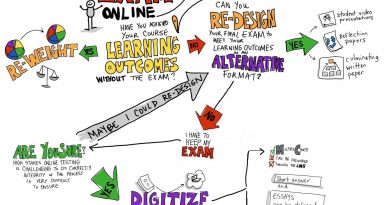Preparing for Your First Day of Teaching – Fall 2020
By Heather Dwyer, Assistant Director, CELT
When your course convenes this fall, students will likely feel a lot of uncertainty, and it’s hard to know how best to approach beginning a course under such unprecedented circumstances. Whether conducted in-person, fully remotely, or in dual modality, the first synchronous meeting is a chance for you to help students process the transition to fall semester while maintaining transparency and empathy. Consider incorporating some of the following ideas:
Communicate and acknowledge the difficulty of the situation.
By the time the semester begins, students will likely have experienced upheaval, distress, and disappointment over the past months. Additionally, you have likely been working to transition your course to fit the various constraints of teaching during a pandemic, and your personal life may now be intersecting with your professional life in complex and challenging ways. Acknowledge to students that this is a time when anxiety is running high for a number of reasons, understandably so, as these circumstances are not normal. Recognize that, yes, this fall will be bumpy, but you and the students will be navigating it together, and that struggle and confusion right now is expected and okay. Emphasize that this process will require empathy and patience with one another, and it can lead to true partnerships among faculty and students.
Conduct a mindfulness exercise.
Given the circumstances, it may be hard for students to be able to focus on your course. Give students a few minutes to transition and become present in the moment. A short interval of stillness, a breathing exercise, or a moment for students to “empty their minds” are all ways to ground students and prepare them for the work of learning. For more guidance, see our resource on Mindfulness in the Classroom.
Clearly communicate course expectations.
Because different courses will be held in various formats/modalities and organized in different ways, it will be especially important to communicate what students can expect in terms of their learning experience. Specifically, make sure students understand how the course is to be run on a day-to-day basis (e.g., synchronous meetings at regularly scheduled times with preparatory work comprised of videos and readings). It can also be helpful to establish netiquette expectations around appropriate self-presentation, guidelines for engagement, sharing airtime, etc. (note that current circumstances may warrant more flexibility than usual regarding netiquette). If you plan to involve students in making any of these decisions, communicate that as well, and make time for that process. One way to make this process more engaging and interactive is to build this information into the syllabus; then, during a synchronous meeting, have students move into breakout groups to participate in a scavenger hunt requiring them to identify the most important aspects of the course expectations.
Give students a chance to connect with you and one another.
It is possible to maintain social connection in a remote learning environment, and that social connection is especially critical in this moment. You might ask:
- How are you feeling about the course/semester?
- What are you most excited about for this course/semester?
- What do you think you will need to have a successful semester?
- What do you remember struggling with the most in the spring/summer?
If you intend to hold your course synchronously over Zoom, you could have students respond over the chat, using the whiteboard tool (which has the benefit of anonymity), or in pairs/small groups using breakout sessions. If you are conducting your course mostly asynchronously, students could share their thoughts using the discussion board in Canvas or in a survey.
Try conducting a small portion of class as you plan to conduct it day-to-day.
It may take time for you and your students to become familiar with the technologies you plan to use. Particularly if you plan to hold synchronous sessions, you could allot some time to have students try using tools as you intend them to be used on a regular basis. This might mean a bit of content delivery using PowerPoint or an interactive prior knowledge check via Polleverywhere.com. Since you and the students may be using certain tools for the first time, the first meeting can be a good time to do a trial run and iron out any issues that immediately arise.
Have students complete a pre-course survey.
Because students are likely navigating different personal and academic circumstances, it can be valuable to check in with each student about their individual needs or concerns. Have students complete a survey, which can be set up in Canvas or Qualtrics. Questions might include:
- Are there barriers or challenges to your participation in synchronous (in real time) meetings that you would like me to know about?
- How proficient do you feel with the online learning environment/educational technology tools we’ll be using? (Students can indicate on a scale of 1-5)
- Please provide your input/opinion on [insert course policy/assessment/course expectation here].
- Where do you feel you need support, academically or otherwise?
- Is there anything else you want me to know?
See Also
*Note this post is an updated version of one posted in March 2020.
Image credit: The Jumbo Statue sits on the academic quad (Kelvin Ma/Tufts University)




